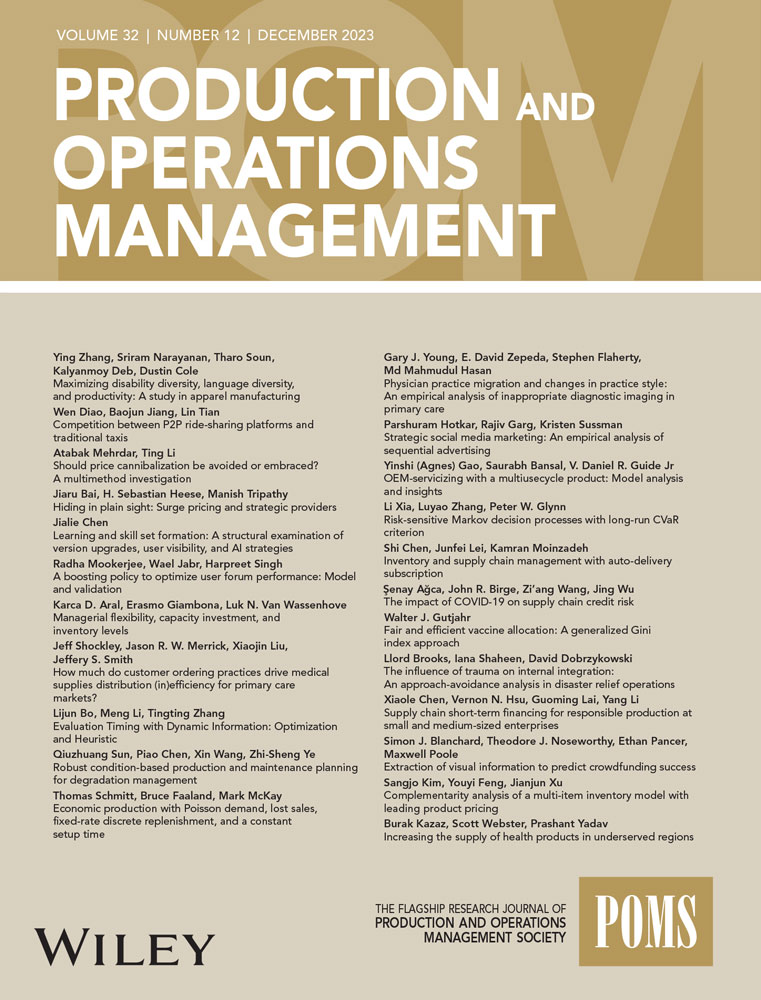仓库运营和车辆路线之间的动力学
IF 5.1
3区 管理学
Q1 ENGINEERING, MANUFACTURING
引用次数: 0
摘要
当安排从仓库向客户分配订购物品时,运输计划通常首先完成,并作为计划仓库操作的输入。当客户交付受到时间窗口的限制,并且仓库的可用资源(订单分拣员和暂存区的空间)有限时,这种顺序方法可能会导致效率低下。本文研究了仓库运营和运输计划之间的权衡。目标是了解三种具体管理干预措施的影响:采用综合规划方法、扩大可用的集结空间和扩大交付时间窗口。为此,我们提出了一个通用车辆路径问题的数学模型,该问题包括订单分批、订单拣选调度、分段和车辆装载。我们引入了一种新的思想,将订单批次的挑选时间表示为批次大小的函数,并开发了一种元启发式方法来解决这个集成问题。此外,我们开发了精确的算法,以在顺序规划方法中为单个仓库和运输问题提供最优解决方案。管理见解是从荷兰一家领先的杂货零售商的两个仓库的案例研究中提炼出来的,一个用于环境产品,另一个用于冷藏产品。我们的研究结果表明,综合规划优于其他管理干预措施,可节省9%至11%的成本。节省通常是通过执行较大的订单批量在仓库中挑选来实现的,而牺牲了额外的路线成本(约2%至3%)。第二种干预措施是将客户交付的时间窗口延长15分钟,可以节省4%至6%的成本,这是由于运输和仓储成本的降低。只有当暂存空间被高度利用时,扩大暂存区的容量才有意义,而且只会为仓库操作节省成本。本文受版权保护。保留所有权利本文章由计算机程序翻译,如有差异,请以英文原文为准。
Dynamics between Warehouse Operations and Vehicle Routing
When scheduling the distribution of ordered items from a warehouse to customers, the transportation planning is generally done first and serves as input for planning warehouse operations. Such a sequential approach can lead to substantial inefficiencies when the customer deliveries are restricted by time windows and the warehouse has limited resources available (both order pickers and space in the staging area). This paper studies the trade‐offs between warehouse operations and transportation planning. The goal is to understand the impact of three specific managerial interventions: adopting an integrated planning approach, expanding the available staging space, and expanding the delivery time windows. To this end, we propose a mathematical model for a general vehicle routing problem that incorporates order batching, order picker scheduling, staging, and vehicle loading. We introduce a novel idea to express the picking time of an order batch as a function of the batch size and develop a metaheuristic to solve this integrated problem. Furthermore, we develop exact algorithms to provide optimal solutions for the individual warehouse and transportation problems in a sequential planning approach. Managerial insights are distilled from case studies in two warehouses, one for ambient products and the other for refrigerated products, of a leading grocery retailer in the Netherlands. Our results show that integrated planning outperforms the other managerial interventions and generates cost savings between 9 and 11%. Savings are generally realized by executing larger order batch sizes to be picked in the warehouses at the expense of additional routing cost (around 2 to 3%). The second intervention in the form of time window expansions of only 15 minutes for customer deliveries can lead to cost savings between 4 to 6%, which results from a reduction in both transportation and warehousing cost. Expanding the capacity of the staging area is only meaningful when the staging space is highly utilized, and only results in cost savings for the warehouse operations.This article is protected by copyright. All rights reserved
求助全文
通过发布文献求助,成功后即可免费获取论文全文。
去求助
来源期刊

Production and Operations Management
管理科学-工程:制造
CiteScore
7.50
自引率
16.00%
发文量
278
审稿时长
24 months
期刊介绍:
The mission of Production and Operations Management is to serve as the flagship research journal in operations management in manufacturing and services. The journal publishes scientific research into the problems, interest, and concerns of managers who manage product and process design, operations, and supply chains. It covers all topics in product and process design, operations, and supply chain management and welcomes papers using any research paradigm.
 求助内容:
求助内容: 应助结果提醒方式:
应助结果提醒方式:


